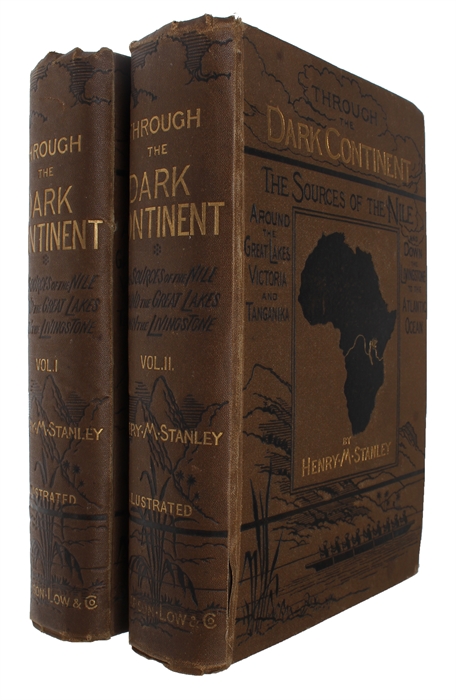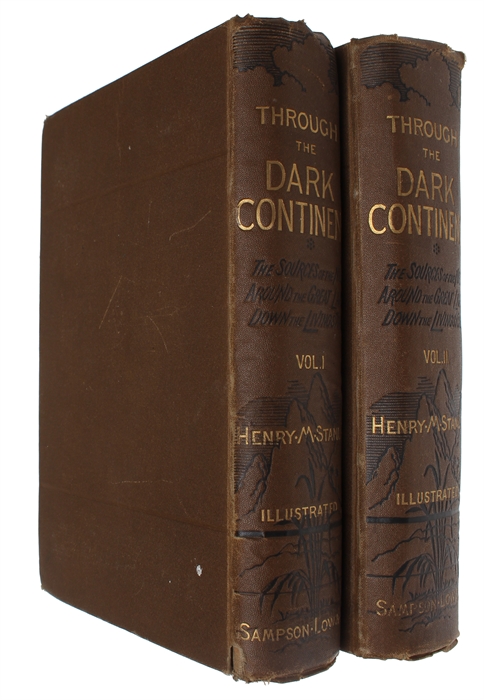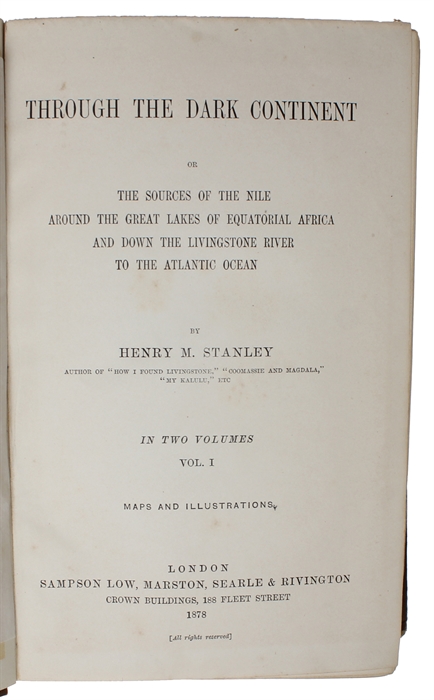"ONE OF THE GREATEST JOURNEYS OF ALL TIME"
STANLEY, HENRY MORTON.
Through the Dark Continent or the sources of the Nile around the great lakes of equatorial Africa and down the Livingstone River to the Atlantic Ocean.
London, Sampson Low, 1878.
8vo. 2 volumes, both in publisher’s original dark brown pictorially decorated cloth, with an elaborate pattern depicting the continent of Africa in black with the Nile crossing it in gilt. Below, also in black, a scene depicting natives roving on a river. Title and author in gilt lettering to front boards and spines. Light wear to extremities, mainly to upper and lower part of capitals. 3 cm tear to lower part of front hindge on vol. 2, otherwise fine and clean. XIV, (2), 522; IX, 566, 32 (publisher's booklist, dated April 1878) pp. + 2 frontispiece portraits, 10 maps including 2 large folding maps in pockets at rear, 33 wood-engraved plates and many illustrations in the text.
First edition of this landmark account, "One of the greatest journeys of all time" (Jeal, Life of Stanley, p.202), on the search for the sources of the Nile. This epic journey, lasting for over two and a half years completed the work of Burton, Speke and Livingstone. Mansell IV p. 379
"The procession that departed from Bagamoyo (Tanzania) on 17 November 1874 stretched for more than half a mile and included dozens of men carrying sections of the Lady Alice, the boat named for his seventeen-year-old fiancée, with which Stanley intended to explore Lakes Victoria and Tanganyika and Livingstone's Lualaba River. During the next two and a half years, the expedition would struggle in temperatures reaching as high as 138 degrees; the powerful Emperor Mtesa of Uganda and the Wanyoro chief Mirambo would consume a great deal of Stanley's time and test his diplomatic skills; he would have to negotiate with a notorious Arab ivory and slave trader named Tippu-Tib for safe passage of his men through the great rain forest; and he and his men would fight more than thirty skirmishes and battles on land and water against hostile tribes.
The geographic prizes Stanley achieved on this expedition were unparalleled. (See the two Stanley maps.) He spent almost two months circumnavigating Lake Victoria, confirming that the only outlet was at Ripon Falls and hence establishing for good, he thought, the source of the Nile. He scouted Lake Albert, then moved south and west to Lake Tanganyika, which he also circumnavigated, proving it had no connection with Lake Albert. Stanley then solved the remaining geographical puzzle, determining that the Lualaba was not part of the Niger or Nile rivers but ultimately flowed into the Congo. He reached the Atlantic Ocean on 9 August 1877, after a journey of more than seven thousand miles, in utter exhaustion. Back in London, he learned that Alice had not waited for him." (Delaney, Princeton Visual Materials, online).
Hilmy, II, p.258
Mendelssohn (1979) IV, p.379.
Order-nr.: 59657



